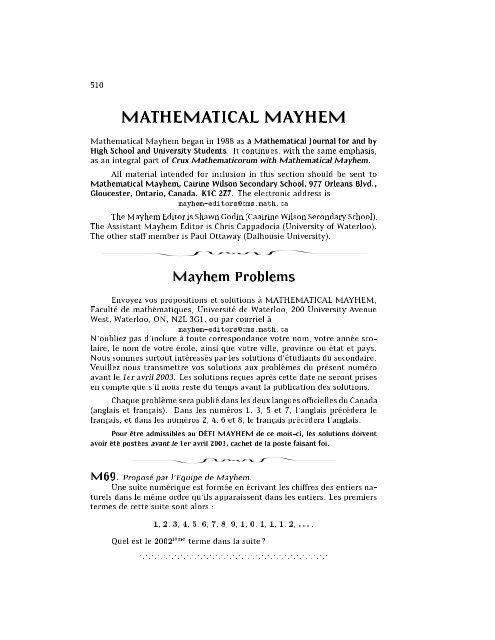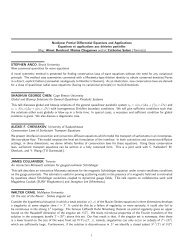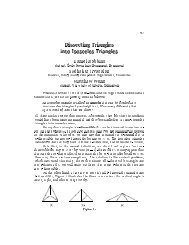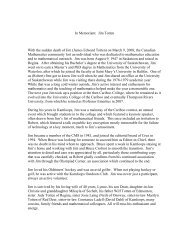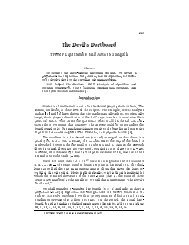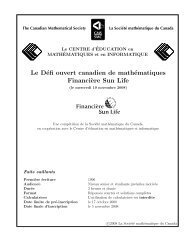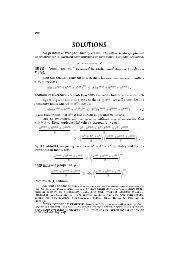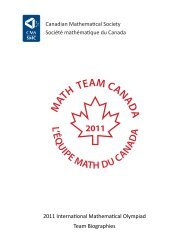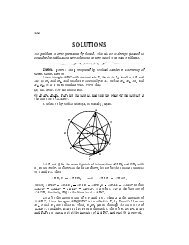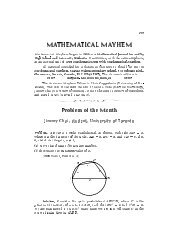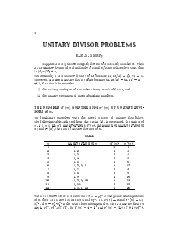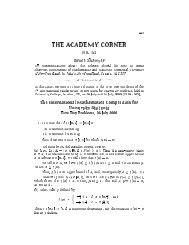MATHEMATICAL MAYHEM - Canadian Mathematical Society
MATHEMATICAL MAYHEM - Canadian Mathematical Society
MATHEMATICAL MAYHEM - Canadian Mathematical Society
Create successful ePaper yourself
Turn your PDF publications into a flip-book with our unique Google optimized e-Paper software.
510<br />
<strong>MATHEMATICAL</strong> <strong>MAYHEM</strong><br />
<strong>Mathematical</strong> Mayhem began in 1988 as a <strong>Mathematical</strong> Journal for and by<br />
High School and University Students. It continues, with the same emphasis,<br />
as an integral part of Crux Mathematicorum with <strong>Mathematical</strong> Mayhem.<br />
All material intended for inclusion in this section should be sent to<br />
<strong>Mathematical</strong> Mayhem, Cairine Wilson Secondary School, 977 Orleans Blvd.,<br />
Gloucester, Ontario, Canada. K1C 2Z7. The electronic address is<br />
mayhem-editors@cms.math.ca<br />
The Mayhem Editor is Shawn Godin (Caairine Wilson Secondary School).<br />
The Assistant Mayhem Editor is Chris Cappadocia (University of Waterloo).<br />
The other sta member is Paul Ottaway (Dalhousie University).<br />
Mayhem Problems<br />
Envoyez vos propositions et solutions a <strong>MATHEMATICAL</strong> <strong>MAYHEM</strong>,<br />
Faculte de mathematiques, Universite de Waterloo, 200 University Avenue<br />
West, Waterloo, ON, N2L 3G1, ou par courriel a<br />
mayhem-editors@cms.math.ca<br />
N'oubliez pas d'inclure a toute correspondance votre nom, votre annee scolaire,<br />
le nom de votre ecole, ainsi que votre ville, province ou etat et pays.<br />
Nous sommes surtout interesses par les solutions d'etudiants du secondaire.<br />
Veuillez nous transmettre vos solutions aux problemes du present numero<br />
avant le 1er avril 2003. Les solutions recues apres cette date ne seront prises<br />
en compte que s'il nous reste du temps avant la publication des solutions.<br />
Chaque probleme sera publie dans les deux langues o cielles du Canada<br />
(anglais et francais). Dans les numeros 1, 3, 5 et 7, l'anglais precedera le<br />
francais, et dans les numeros 2, 4, 6 et 8, le francais precedera l'anglais.<br />
Pour ^etre admissibles au DEFI <strong>MAYHEM</strong> de ce mois-ci, les solutions doivent<br />
avoir ete postees avant le 1er avril 2003, cachet de la poste faisant foi.<br />
M69. Propose par l'Equipe de Mayhem.<br />
Une suite numerique est formee en ecrivant les chi res des entiers naturels<br />
dans le m^eme ordre qu'ils apparaissent dans les entiers. Les premiers<br />
termes de cette suite sont alors :<br />
1, 2, 3, 4, 5, 6, 7, 8, 9, 1, 0, 1, 1, 1, 2, : ::.<br />
Quel est le 2002 ieme terme dans la suite?<br />
. . . . . . . . . . . . . . . . . . . . . . . . . . . . . . . . . . . . . . . . . . . . . . . . . . . . . . . . . . . . . . . . .
511<br />
A sequence of digits is formed by writing the digits from the natural<br />
numbers in the order that they appear. The sequence starts:<br />
1, 2, 3, 4, 5, 6, 7, 8, 9, 1, 0, 1, 1, 1, 2, : ::.<br />
What is the 2002 nd digit in the sequence?<br />
M70. Propose par l'Equipe de Mayhem.<br />
Quel est le plus petit multiple positif de 15 qui est forme uniquement<br />
par les chi res 0, 4 et 7, chacun apparaissant le m^eme nombre de fois ?<br />
. . . . . . . . . . . . . . . . . . . . . . . . . . . . . . . . . . . . . . . . . . . . . . . . . . . . . . . . . . . . . . . . .<br />
What is the smallest positive multiple of 15 that is made up of only the<br />
digits 0, 4 and 7, each appearing the same number of times?<br />
M71. Propose par Richard Hoshino, Universite Dalhousie, Halifax,<br />
Nouvelle Ecosse.<br />
Soit a, b et c trois nombres premiers et posons x = a + b ; c,<br />
y = a + c ; b et z = b + c ; a. Sachant que x 2 = y et que p z ; p y<br />
est le carre d'un nombre premier, determiner toutes les valeurs possibles<br />
pour le produit abc.<br />
. . . . . . . . . . . . . . . . . . . . . . . . . . . . . . . . . . . . . . . . . . . . . . . . . . . . . . . . . . . . . . . . .<br />
Let x = a + b ; c, y = a + c ; b and z = b + c ; a, where a, b and<br />
c are prime numbers. Given that x 2 = y and p z ; p y is the square of a<br />
prime number, determine all possible values for the product abc.<br />
M72. Propose par J. Walter Lynch, Athens, GA, USA.<br />
Vous avez une tasse de cafe et une tasse de the. Les tasses sont identiques<br />
et chacune contient la m^eme quantite de liquide que l'autre. Vous<br />
prenez une cuillere de cafe de la tasse de cafe et la mettez dans la tasse de<br />
the. Vous prenez ensuite une cuillere du melange de la tasse de the et vous<br />
la mettez dans la tasse de cafe. Comparer les quantites suivantes :<br />
{ la quantite de cafe dans la tasse de the<br />
{ la quantite de the dans la tasse de cafe<br />
. . . . . . . . . . . . . . . . . . . . . . . . . . . . . . . . . . . . . . . . . . . . . . . . . . . . . . . . . . . . . . . . .<br />
You have a cup of co ee and a cup of tea. The cups are identical and<br />
each contains the same amount of liquid as the other. You take a teaspoon<br />
full of co ee out of the co ee cup and put it into the teacup. You then take a<br />
teaspoon full of the mixture out of the teacup and put it into the co ee cup.<br />
Which is greater, the amount of co ee in the teacup, the amount of tea in the<br />
co ee cup, or are they the same?<br />
M73. Propose par J. Walter Lynch, Athens, GA, USA.<br />
Un cylindre droit de rayon r et de hauteur h contient du liquide jusqu'a<br />
x du haut du cylindre. Trouver l'angle d'inclinaison du cylindre a n que le<br />
liquide commence a ^etre verse. (On suppose qu'il y a su sament de liquide<br />
a n que la surface du liquide n'intersecte pas le fond du cylindre avant que<br />
le liquide commence a ^etre verse.)
512<br />
A right circular cylinder with radius r and height h contains a liquid to<br />
within x of the top of the cylinder. Find the angle through which the cylinder<br />
must be tilted in order for the liquid to start to pour out. (Assume that there<br />
is enough liquid in the cylinder so that the surface of the liquid does not<br />
intersect the bottom of the cylinder before the liquid starts to pour out.)<br />
M74. Propose par l'Equipe de Mayhem.<br />
12 points sont egalement espaces sur la circonference d'un cercle. De<br />
combien de facons peut-on associer les entiers de 1 a 12 a ces 12 points de<br />
telle maniere que lorsqu'on rejoint ces points par les lignes droites, en ordre,<br />
ces droites ne sont pas concourantes ? Un exemple d'un mauvais arrangement<br />
est illustre ci-dessous.<br />
2<br />
5<br />
9<br />
8<br />
12<br />
3<br />
4<br />
A circle has 12 equally spaced points placed on its circumference. How<br />
many ways can the numbers 1 through 12 be assigned to the points so that<br />
if the points 1 through 12 are connected with line segments, in order, the<br />
segments do not cross? An example of a bad arrangement is illustrated above.<br />
M75. Propose par l'Equipe de Mayhem.<br />
Les termes de la suite croissante 1, 5, 6, 25, 26, 30, 31, 125, 126, : ::<br />
sont obtenus en ajoutant des puissances distinctes de 5. Quel est le 75 ieme<br />
terme de cette suite?<br />
. . . . . . . . . . . . . . . . . . . . . . . . . . . . . . . . . . . . . . . . . . . . . . . . . . . . . . . . . . . . . . . . .<br />
The increasing sequence 1, 5, 6, 25, 26, 30, 31, 125, 126, ::: consists<br />
of positive integers that can be formed by adding distinct powers of 5. What<br />
is the 75 th integer in the sequence?<br />
7<br />
6<br />
11<br />
10<br />
1
Mayhem Solutions<br />
513<br />
M19. Proposed by the Mayhem sta .<br />
On the magical island of Xurc, there lives a giant Ecurb. Ecurb has an<br />
unlimited supply of special coins that are worth one million dollars each.<br />
Ecurb allows people to go into his castle and take as many of these coins as<br />
they like, but, they must give some up in order to cross the bridges to leave<br />
his island. At each of the ve bridges Ecurb demands that you give 99<br />
100 of<br />
a coin more than 99<br />
100<br />
of the coins in your possession. Coins cannot be cut<br />
or broken in any way. If the demand cannot be met Ecurb takes all of your<br />
coins and eats one of your feet. How many coins do you have to start with<br />
in order to make it o the island with exactly one coin (and both feet)?<br />
Solution.<br />
Suppose you have Z coins before you come to a bridge, and you have<br />
X coins after you cross the bridge. The relationship between Z and X is<br />
given by<br />
Z ; (0:99 + 0:99Z) = X ,<br />
Z = 100X + 99 .<br />
You have one coin after you cross the fth bridge. Using the relationship<br />
above, you will have had 199 coins just before crossing the fth bridge.<br />
Apply this relationship repeatedly then you will have had 19999 coins just<br />
before crossing the fourth bridge, 1999999 coins before crossing the third,<br />
199999999 before crossing the second, and 19999999999 before crossing the<br />
rst.<br />
Therefore, you have to start with exactly 19999999999 coins to make it<br />
o the island with exactly one coin (and both feet).<br />
M20. Proposed by Richard Hoshino, Dalhousie University, Halifax,<br />
Nova Scotia.<br />
Suppose that A, B and C are positive integers in arithmetic progression<br />
with A < B < C < 180 .<br />
If sin A + sin B = sin C and cos A ; cos B = cos C, determine<br />
the triplet (A B C).<br />
Solution.<br />
Let A = B ; d and C = B + d for some integer 0 d < 90 .<br />
Then<br />
sin (B ; d ) + sin B = sin (B + d ) ,<br />
sin B cos d ; sin d cos B + sin B = sin B cos d + sin d cos B ,<br />
sin B = 2 sin d cos B , (1)
514<br />
and<br />
cos (B ; d ) ; cos B = cos (B + d ) ,<br />
cos B cos d + sin B sin d ; cos B = cos B cos d ; sin B sin d ,<br />
cos B = 2sinB sin d . (2)<br />
Substituting (2) into (1) gives<br />
sin B = 2 sin d (2 sin B sin d ) ,<br />
sin B = 4 sin 2 d sin B .<br />
And sin B 6= 0, since 0 < B < 180 . Hence, sin 2 d = 1<br />
, whereupon<br />
sin d = 1<br />
, since 0 d < 90 . Therefore, d = 30 .<br />
2<br />
Substituting sin d = 1<br />
into (1) gives sin B = cos B , from which it<br />
2<br />
follows that B = 45 . Therefore, A = 15, B = 45, and C = 75.<br />
M21. Proposed by the Mayhem sta .<br />
Find all positive integers a, b, c, d, and e which satisfy<br />
a! = b! + c! + d! + e! .<br />
Solution.<br />
Suppose that a > b c d e 1. Then, a! 4e! 4, implying<br />
a 3.<br />
Since a > b, we have a! a(b!). But then a! = b! + c! + d! + e! gives<br />
a! 4b!, which forces a 4. Thus, we have a = 3 or a = 4.<br />
When a = 3, we have b! + c! + d! + e! = 6. We must have b, c, d,<br />
and e all strictly less than 3, and at least 1. A quick inspection shows that<br />
b, c, d, and e must be some arrangement of 2, 2, 1, and 1, after we lift the<br />
restriction on the order of b, c, d, and e.<br />
When a = 4, we have b! + c! + d! + e! = 24. We must have b, c, d,<br />
and e all strictly less than 4. Thus, b! + c!+d! + e! 3! + 3! +3!+3! = 24<br />
and, in fact, we must take b = c = d = e = 3 so that the equality holds.<br />
M22. Proposed by the Mayhem sta .<br />
George is walking across a bridge on the train track. When he is 5<br />
12 of<br />
the way across the bridge he notices a train bearing down on him at 90 km/h.<br />
If he can just escape death by running in either direction, how fast can George<br />
run?<br />
Solution.<br />
Let the length of the bridge be b metres. George is 5<br />
4<br />
12<br />
b metres<br />
away from one end of the bridge and 7<br />
b metres away from the other end of<br />
12<br />
the bridge.
515<br />
The train is heading towards George at 90 km/h, or 25 m/s, and the<br />
end of the bridge that is closest to George is between George and the train<br />
(since the train is \bearing down on him"). Let the train be d metres away<br />
from the closest end of the bridge.<br />
Let George's top speed be x m/s.<br />
Now, it takes both George and the train the same amount of<br />
time to reach the end of the bridge that is closest to George. George takes<br />
5b<br />
d<br />
seconds to reach the close end of the bridge. The train takes<br />
12x 25 seconds<br />
to reach the close end of the bridge.<br />
Thus, 5b d<br />
=<br />
12x 25 or<br />
12x = 125 b<br />
d<br />
It also takes both George and the train the same amount of time to reach the<br />
far end of the bridge. From this we obtain the equality 7b b + d<br />
=<br />
12x 25 or<br />
12x = 175 b<br />
b + d<br />
Comparing (1) and (2) we get 125 b<br />
b<br />
b b 2<br />
= 175 and solving for gives =<br />
d b + d d d 5 .<br />
Substituting this value into (1) gives 12x = 125 2<br />
George can run at a speed of 25<br />
6<br />
m/s = 15 km/h.<br />
5<br />
(1)<br />
(2)<br />
25<br />
or x = . Therefore,<br />
6<br />
M23. Proposed by Jose Luis D az-Barrero and Juan Jose Egozcue,<br />
Barcelona, Spain.<br />
Find all complex solutions of the following system of equations<br />
x 3 + y 3 + z 3 + t 3 = 12 ,<br />
x 2 + y 2 + z 2 + t 2 = 0 ,<br />
xy + zt + (x + y)(z + t) = 0 ,<br />
xyzt = 3 .<br />
Solution by Mihaly Bencze, Brasov, Romania.<br />
(x + y + z + t) 2<br />
= x 2 + y 2 + z 2 + t 2 + 2xy + 2zt + 2xz + 2xt + 2yz + 2yt<br />
= (x 2 + y 2 + z 2 + t 2 ) + 2(xy + zt + (x + y)(z + t))<br />
= 0 + 2(0) = 0 .<br />
Thus, x + y + z + t = 0.<br />
Now notice that
516<br />
0 = (x + y + z + t)(x 2 + y 2 + z 2 + t 2 ; xy ; zt ; xz ; xt ; yz ; yt)<br />
= x 3 + y 3 + z 3 + t 3 ; 3(xyz + yzt + ztx + txy) .<br />
And since x 3 + y 3 + z 3 + t 3 = 12, we have xyz + yzt + ztx + txy = 4.<br />
Thus, we have,<br />
x + y + z + t = 0 ,<br />
xy + zt + xz + xt + yz + yt = 0 ,<br />
xyz + yzt + ztx + txy = 4 ,<br />
xyzt = 3 .<br />
Therefore, x, y, z, and r are the roots of the quartic equation<br />
r 4 ; 0r 3 + 0r 2 ; 4r + 3 = 0 ,<br />
r 4 ; 4r + 3 = 0 ,<br />
(r ; 1) 2 (r 2 + 2r + 3) = 0 ,<br />
with the roots 1, 1, ;1 + i p 2, and ;1 ; i p 2. Therefore, x, y, z, and r are<br />
some arrangement of these four roots.<br />
M24. Proposed by the Mayhem sta .<br />
A school math club is deciding on a name for its mascot, a stu ed rabbit.<br />
They have narrowed the choices down to three: Euler, Galois and Ramanujan.<br />
To pick the name they have each of the 100 club members rank the names<br />
in order of preference. When the polls were totalled it was found that 60<br />
people preferred Galois over Ramanujan and 62 preferred Ramanujan over<br />
Euler. It was suggested, by a Galois supporter, that Euler should be dropped.<br />
A staunch Eulerist objected and demanded the counting continue. When the<br />
nal totals came in, it was found that 68 preferred Euler over Galois! If each<br />
possible ranking was picked by at least one member, how many picked each<br />
name as their rst choice?<br />
Editor's Note: The problem as stated does not have a unique solution.<br />
The problem will be restated in a future issue in a form that is solvable. Sorry<br />
for the inconvenience.<br />
M25. Proposed by the Mayhem sta .<br />
What is the smallest number with the property that when the rst digit<br />
(leftmost) is moved to the rightmost position, the new number is three times<br />
the original?<br />
Solutions by Robert Bilinski, Outremont, PQ and by Gustavo Krimker,<br />
Universidad CAECE, Argentina. We give Bilinski's solution.<br />
nP<br />
P<br />
10<br />
k=0<br />
kak = 10n n;1<br />
an +<br />
k=0<br />
to 9, with an 6= 0 and an;1 6= 0.<br />
10 k ak, with a0, ..., an single digits from 0
We want to nd the smallest n which allows a solution to<br />
n;1 X<br />
k=0<br />
which simpli es to<br />
10 k+1 ak<br />
X<br />
n;1<br />
7<br />
k=0<br />
!<br />
X<br />
+ an = 3(10 n n;1<br />
)an + 3 10 k ak ,<br />
k=0<br />
10 k ak = ((3)10 n ; 1)an .<br />
517<br />
Then an 6= 7 since the left side has n ; 1 digits while the right side has n<br />
digits. Hence, we must nd the rst n such that (3)10 n ; 1 is divisible by 7.<br />
By inspection, n = 5. Now (3)10 n ; 1 = 299999 = 7(42857).<br />
P<br />
Therefore, n;1<br />
10<br />
k=0<br />
kak = 42857a5.<br />
Of course, we want the smallest possible a5. Thus, we get the solution<br />
a5 = 1, a4 = 4, a3 = 2, a2 = 8, a1 = 5, and a0 = 7. Therefore, 142857 is<br />
the smallest number satisfying the given conditions.<br />
Polya's Paragon<br />
Paul Ottaway<br />
This month's article is inspired by a rather famous tiling problem involving<br />
dominoes and a chessboard. In case you are unfamiliar with it, I will<br />
pose it again here:<br />
You are given an 8 8 chessboard and a supply of 2 1 dominoes that<br />
cover exactly 2 adjacent spaces on the chessboard. Is it possible to cover a<br />
board that is missing opposite corners with exactly 31 dominoes? None of<br />
the dominoes may overlap or hang o the edge of the board. I will for the<br />
rest of the article, call this a `tiling'.<br />
Clearly, it is easy to tile a complete board with exactly 32 dominoes by<br />
placing 4 along each row (or column). If we remove 2 spaces from the board,<br />
it would seem that shifting the dominoes in some way would allow us to tile<br />
the board with one less domino. In this particular case, it can never be done!<br />
The proof of this is one of my favourites since it is so simple and concise.<br />
When a domino is placed on the board, it covers exactly 1 black square<br />
and 1 white square (assuming the standard alternating colouring of such a<br />
board). When we remove opposite corners, they have the same colour (say<br />
white). Now our board has 32 black squares and 30 white squares. Since we<br />
can cover at most 1 black space with each domino, it will be impossible to
518<br />
cover the entire board with exactly 31 dominoes. Of course, if we were to<br />
remove any two squares of the same colour, there would be no way to tile<br />
the board for exactly the same reason.<br />
The natural problem to now ask is: If we remove one black square and<br />
one white square from the board, is there always a way to cover the board<br />
with 31 dominoes?<br />
In some senses, this should be easier than the original problem. To<br />
prove that something never occurs, we must be sure to do it in complete<br />
generality. To show that something is possible, all we have to do is show how<br />
to do it. For this reason, our previous argument is no longer useful | if we<br />
remove opposite colour spaces we only know that a tiling may exist. We need<br />
to construct a tiling that uses 31 dominoes that will cover a chessboard that<br />
is missing one black and one white space. Consider the following diagram:<br />
a<br />
This snake-like pattern is what will give us the result. If we remove one<br />
space of each colour (a and b), we are left with 2 'paths' from a to b. Each path<br />
will consist of an even number of spaces since it must begin with one colour<br />
and end with the other. Thus, we can cover each path perfectly with some<br />
number of dominoes. Since the two paths cover all the spaces except a and b,<br />
we have tiled all 62 remaining spaces of the board with exactly 31 dominoes.<br />
I should be careful and note that if two adjacent spaces are removed, we can<br />
sometimes get a path of length 0 between them, but that will not hinder the<br />
proof any. This result is more commonly known as Gomory's Theorem.<br />
Let us now move on to some similar problems that we might tackle in<br />
much the same way: Is it possible to tile a 10 10 board with a supply of<br />
pieces like this?<br />
b
519<br />
Well, let us begin by assuming our board is coloured much like a chessboard<br />
with alternating black and white spaces. Each piece will cover 3 spaces<br />
of one colour and 1 space of the other. In either case, it is important to note<br />
that they cover an odd number of spaces of a given colour. Now we examine<br />
the board as a whole. If a tiling does exist, we must use exactly 25 pieces<br />
(since each covers 4 spaces, and the board has 100 spaces). Here is where<br />
we run into a problem. Let us look at how many black spaces we are covering.<br />
There are 25 tiles that cover 1 or 3 black spaces on the board. We also<br />
know that the board has 50 black spaces. That means that the sum of 25 odd<br />
numbers must be exactly 50! Of course this can never be true, so that a tiling<br />
does not exist.<br />
That was certainly more work than the rst problem, but still came<br />
down to a relatively simple argument about even and odd numbers | parity.<br />
Let us try this problem one more time:<br />
Is it possible to tile a 10 10 board with a supply of pieces like this?<br />
It seems as though our previous method is no longer going to work.<br />
When we place this piece on the board it will cover 2 black squares and 2<br />
white squares which will only end up telling us that a tiling may exist. I am<br />
going to leave this problem as an exercise, but I will give you a hint | try a<br />
di erent colouring of the board!<br />
Here is another interesting tiling problem which I ran across last year:<br />
Is it possible (for all n > 0) to tile a 2 n 2 n board with exactly 1<br />
(arbitrarily chosen) space removed if we are given a supply of pieces like<br />
this?<br />
The answer to this problem is yes! The proof is by induction:<br />
First note that for n = 1, we need only 1 piece to tile the board. Let us<br />
now assume that we can tile the board for some n = k and construct a tiling<br />
of the board for n = k + 1.<br />
First, we divide the board into 4 quadrants each of side length 2 k . The<br />
missing space is in one of the quadrants, so that, by induction, we can tile<br />
that quadrant perfectly. For each of the other quadrants, we can tile them<br />
perfectly by leaving exactly one space empty. If we tile them all so that space<br />
closest to the middle of the board is left empty, we are left with a board that
520<br />
is completely tiled except for 3 spaces in the centre that can be lled by one<br />
more piece.<br />
2 k<br />
2 k<br />
2 k 2 k<br />
Since we have now completely tiled the board for n = k +1, by induction<br />
we conclude that it is possible to tile all such boards.<br />
In my experience, these types of problems are the most fun to work on<br />
because they do not require too much mathematical background | and you<br />
get to play with little pieces. Here are some related tiling problems that I<br />
hope you nd entertaining:<br />
PROBLEMS:<br />
1. We have already discussed the 10 10 board using 2 di erent 4{space<br />
tiles (tetris pieces). Try repeating this problem with the other 3 types<br />
of 4{space tiles (the line, box and zig-zag). Which one(s) work and what<br />
sort of colourings do you need to prove otherwise?<br />
2. If we do not count re ections, there are actually 7 di erent 4{space tiles<br />
(tetris pieces). Is it possible to tile any rectangle with each piece used<br />
exactly once?<br />
3. Is it possible to `tile' an 8 8 8 box with `tiles' of size 2 1 1, if<br />
opposite 1 1 1 corners are removed from the box? Think about the<br />
colouring carefully!<br />
4. Is it possible to `tile' a box with side length 2 n with a single 1 1 1<br />
space missing with 2 2 2 `tiles' that are also missing a 1 1 1 space.<br />
This is a little hard to visualize, but it is the 3{dimensional version of<br />
induction proof above.
Year End Wrap Up<br />
Shawn Godin<br />
521<br />
Well another year has come to an end (funny how the year ends in October<br />
for an editor!). The new format of Mayhem seems to be taking form and we<br />
are slowly starting to hear from more students, which is what we want. To<br />
you new contributors to Crux with Mayhem, welcome, and please continue<br />
to be part of our little family. We are always open to suggestions on how to<br />
make your journal better for you.<br />
This year saw the introduction of the Mayhem Taunt, thanks to the<br />
generous support of the Endowment Fund of the CMS. We are just sorting<br />
out prizes for the rst four Mayhem Taunts, and the prizes will be announced,<br />
and solutions printed, in 2003. The money from the Endowment Fund will<br />
be used up on prizes from the 2002 Taunt, but we are hoping to o er some<br />
sort of continued prizes : :: keep posted.<br />
At this point I would like to thank some people who make Mayhem<br />
possible. First, and foremost, I would like to thank Mayhem assistant editor<br />
CHRIS CAPPADOCIA. Chris has taken on a larger, more regular, role this<br />
year and has really pulled through for me when I needed him.<br />
GRAHAM WRIGHT at the CMS headquarters in Ottawa has continued<br />
to be a large asset. Graham has been a strong supporter of my ideas with<br />
<strong>MAYHEM</strong>. Along with the sta at the CMS o ce, they have been able to<br />
provide me with materials for Taunt prizes and the necessities of editing this<br />
section.<br />
The rest of the Mayhem Sta : JIMMY CHUI and PAUL OTTAWAY have<br />
continued to dedicate their time to make <strong>MAYHEM</strong> all it is. We bid farewell<br />
to Jimmy as he pursues his studies, all the best. Your dedication and hard<br />
work over the years is greatly appreciated we will miss you.<br />
Some other people who have been helpful over the year need to be<br />
mentioned for their continued help \behind the scenes" : ARLENE ANGEL,<br />
DAVID BRIGGS, BILL CLARKE, ELIZABETH ELTON, RICHARD HOSHINO,<br />
and JOSEPH KHOURY.<br />
Finally a big thank you and farewell to our outgoing Editor-in-Chief<br />
BRUCE SHAWYER. Bruce has been a big asset and very supportive over my<br />
rst two years on the job. Since taking over at Crux, Bruce has continually<br />
improved an already great journal. All the best in your future endeavours,<br />
and if you get too restless with your new found freedom, we are always looking<br />
for material.<br />
All the best of the season to our readers and contributors. Crux with<br />
Mayhem is a function of our sta and our readers. Continue helping us make<br />
our journal grow. Happy problem solving. We will see you in 2003.
522<br />
SKOLIAD No. 66<br />
Shawn Godin<br />
Solutions may be sent to Shawn Godin, Cairine Wilson S.S., 975 Orleans<br />
Blvd., Orleans, ON, CANADA, K1C 2Z5, or emailed to<br />
mayhem-editors@cms.math.ca.<br />
Please include on any correspondence your name, school, grade, city, province<br />
or state and country. We are especially looking for solutions from high school<br />
students. Please send your solutions to the problems in this edition by<br />
1 April 2003. A copy of <strong>MATHEMATICAL</strong> <strong>MAYHEM</strong> Vol. 8 will be presented<br />
to the pre-university reader(s) who send in the best set of solutions before<br />
the deadline. The decision of the editor is nal.<br />
Our rst entry this issue comes from the Junior Balkan <strong>Mathematical</strong><br />
Olympiad. My thanks go to the Competition Committee of the Greek <strong>Mathematical</strong><br />
<strong>Society</strong> for forwarding the material to Robert Woodrow, and my<br />
thanks to Robert for forwarding the material to me.<br />
2 nd Junior Balkan <strong>Mathematical</strong> Olympiad<br />
16 - 21 June, 1998, Athens, Greece<br />
(for students up to 15.5 years old)<br />
1. (Yugoslavia) Prove that the number<br />
is a perfect square.<br />
| {z } | {z }<br />
11 ::: 111 22 : ::222 5<br />
1997<br />
1998<br />
2. (Greece) Let us consider a convex pentagon ABCDE, with AB =<br />
AE = CD = 1, \ABC = \DEA = 90 and BC + DE = 1. Find the area<br />
of the pentagon.<br />
3. (Albania) Find all pairs of positive integers (x y) that satisfy the<br />
following equation: x y = y x;y .<br />
4. (Bulgaria) Using only three digits can one write 16 three-digit numbers,<br />
such that no two of them are giving the same remainder divided by<br />
16.<br />
Our next contest comes from the BC Mathematics Competitions. My<br />
thanks go to Jim Totten of the University College of the Cariboo and Clint<br />
Lee of Okanagan University College for forwarding the material to me.
BRITISH COLUMBIA COLLEGES<br />
Junior High School Mathematics Contest, 2002<br />
Preliminary Round<br />
March 6, 2002<br />
523<br />
1. The year 2002 is a palindromic number that is, it reads the same<br />
forwards and backwards. The number of years in the third millennium that<br />
is, between the years 2001 and 3000, that have this property is:<br />
(a) 1 (b) 10 (c) 11 (d) 99 (e) 100<br />
2. I have just won 50 of 75 games of \Free Cell" on the computer. The<br />
number of games out of the next 30 games that I must win in order to have<br />
won 60% overall is:<br />
(a) 10 (b) 13 (c) 15 (d) 20 (e) 25<br />
3. Mark sold two computers each for $198. The rst was sold for a<br />
pro t of 10%, the other for a loss of 10%. Overall, Mark had:<br />
(a) a loss of $8 (b) a loss of $4 (c) no pro t or loss<br />
(d) a gain of $4 (e) a gain of $8<br />
4. Among the following numbers the one that is a multiple of 9 is:<br />
(a) 1233124 (b) 4623747 (c) 37438974 (d) 67346438 (e) 5955006<br />
5. A boy and a girl are sitting on the steps outside of their school. \I'm<br />
a boy", said the one with black hair. \I'm a girl", said the one with red hair.<br />
If at least one of them is lying, then:<br />
(a) the boy has red hair and the girl has black hair<br />
(b) the boy has red hair and the girl has red hair<br />
(c) the boy has black hair and the girl has black hair<br />
(d) the boy has black hair and the girl has red hair<br />
(e) the hair colours cannot be determined<br />
(a)<br />
6. The number of triangles in the gure is:<br />
7. If a<br />
b<br />
9<br />
16<br />
(a) 15 (b) 20 (c) 25<br />
(d) 30 (e) more than 30<br />
3 b<br />
= ,<br />
4 c<br />
(b) 81<br />
64<br />
8 c<br />
= , and<br />
9 d<br />
(c)<br />
= 2<br />
3<br />
27<br />
32<br />
ad<br />
, then the value of is:<br />
b2 (d) 4<br />
9<br />
(e)<br />
9<br />
64
524<br />
8. In the preliminary round of the British Columbia Colleges High<br />
School Mathematics Contest there are ve points awarded for each correct<br />
answer, no points for each incorrect answer, and one point for each unanswered<br />
question to a maximum of ve unanswered questions. The number<br />
of scores between 0 and 75 that are not achievable as a valid score for the<br />
fteen questions on the contest is:<br />
(a) 4 (b) 5 (c) 6 (d) 7 (e) more<br />
than 8<br />
9. Old Mr. Jones celebrated his 86 th birthday with all of his descendants<br />
and their spouses, a total of 86 people including Mr. Jones. This included<br />
all of his children each with his or her spouse, all of his grandchildren each<br />
with his or her spouse, and all of his great-grandchildren, none of whom are<br />
married. He has three times as many grandchildren as children and three<br />
times as many great-grandchildren as grandchildren. The number of spouses<br />
of his children and grandchildren present is:<br />
(a) 5 (b) 10 (c) 15 (d) 17 (e) 20<br />
10. In the diagram all adjacent sides meet at right<br />
angles. If the area of the gure is 60 square units, and if<br />
3 < x < 5, then:<br />
(a) 0:5 < h < 3:5 (b) 1:5 < h < 5:5<br />
(c) 2:5 < h < 6:5 (d) 3:5 < h < 8:5<br />
(e) 6 < h < 10<br />
11. In the triangle ABC in the<br />
diagram, point D bisects side AB, point<br />
G bisects side AC, and the points E and<br />
F trisect side BC. If the area of triangle<br />
ABC is 84, then the area of the shaded<br />
polygon ADEF G is:<br />
(a) 252<br />
5<br />
(b) 336<br />
5<br />
(d) 56 (e) 63<br />
(c) 42<br />
A<br />
B E F<br />
C<br />
12. Antonino has two equal square pieces of cookie dough, each of the<br />
same uniform thickness. On one square Antonino makes the largest possible<br />
circular cookie and on the other he makes sixteen equal circular cookies.<br />
Assuming each circle is inscribed in identical non-overlapping square sections<br />
which comprise the whole of the original square piece of cookie dough, the<br />
ratio of the volume of the large cookie to the total volume of the sixteen<br />
smaller cookies is:<br />
(a) p 2 : 1 (b) 1 : p 2 (c) 2 p 2 : (d) : 2 p 2 (e) 1 : 1<br />
D<br />
x<br />
h<br />
G<br />
h<br />
x
525<br />
13. Samantha spent a total of $420 for daily expenses during her vacation<br />
in Mexico. She noted that if she spent $7 less per day, she could have<br />
stayed for another ve days. The number of days she actually spent on her<br />
vacation is:<br />
(a) 15 (b) 18 (c) 22 (d) 29 (e) 30<br />
14. A solid rectangular block with a 5 cm by 5 cm square base has a<br />
height of x cm. If the surface area of the block is 120 cm 2 , then x equals:<br />
(a) 2 (b) 2:5 (c) 3:5 (d) 4 (e) 4:8<br />
15. The number of real numbers for which the reciprocal of the number<br />
is exactly one third of the number is:<br />
(a) 4 (b) in nite (c) 0 (d) 1 (e) 2<br />
Next we turn to the solutions of the Eighteenth W.J. Blundon Contest<br />
presented in issue 3 of this year [2002 : 161].<br />
1. (a) At a meeting of 100 people, every person shakes hands with every<br />
other person exactly once. How many handshakes are there in total?<br />
Solution by Sang-oh Lee, student, grade 11, Rideau High School, Ottawa,<br />
Ontario.<br />
The rst person would shake hands with 99 people, the second person<br />
would shake hands with 98 people, and so on. Thus, the total number of<br />
handshakes is<br />
99 100<br />
99 + 98 + 97 + + 2 + 1 + 0 =<br />
2<br />
= 4950 .<br />
Also solved by Pieta Brown, student, year 10, Diolesan School For Girls,<br />
Auckland, New Zealand and Al an Smu, Indonesia.<br />
(b) How many four digit numbers are divisible by 5?<br />
Solution by Pieta Brown, student, year 10, Diolesan School For Girls,<br />
Auckland, New Zealand.<br />
Four digit numbers divisible by 5 have last digits of 0 or 5. There are 9<br />
possible choices for the rst digit (zero may not be included) then 10 for the<br />
second and third giving 9 10 10 2 = 1800 such numbers.<br />
Also solved by Sang-oh Lee, student, grade 11, Rideau High School,<br />
Ottawa, Ontario and Al an Smu, Indonesia.
526<br />
2. Show that n 2 + 2 is divisible by 4 for no integer n.<br />
I. Solution by Sang-oh Lee, student, grade 11, Rideau High School,<br />
Ottawa, Ontario.<br />
If n is odd, then n 2 and n 2 + 2 are both odd thus, there are no odd<br />
solutions.<br />
If n is even, let n = 2k for some integer k. Thus, n 2 = (2k) 2 = 4k 2 is<br />
divisible by 4, so that n 2 + 2 is not divisible by 4.<br />
Thus, there are no integers n such that n 2 + 2 is divisible by 4.<br />
II. Solution by Pieta Brown, student, year 10, Diolesan School For Girls,<br />
Auckland, New Zealand.<br />
n 2 0, 1 (mod 4) for any integer n. Hence, n 2 + 2 2, 3 (mod 4)<br />
and can therefore not be divisible by 4.<br />
Also solved by Siwen Sun, student, sec. 3, College Saint-Louis, Lachine,<br />
Quebec.<br />
3. Prove that the di erence of squares of two odd integers is always<br />
divisible by 8.<br />
Solution by Pieta Brown, student, year 10, Diolesan School For Girls,<br />
Auckland, New Zealand.<br />
Odd integers are congruent to 1, 3, 5, or 7 (mod 8), the squares of all<br />
such numbers being 1 (mod 8). Therefore, if a and b are two odd numbers<br />
then a 2 ; b 2 1 ; 1 0 (mod 8), as desired.<br />
Also solved by Sang-oh Lee, student, grade 11, Rideau High School, Ottawa,<br />
Ontario, Al an Smu, Indonesia and Siwen Sun, student, sec. 3, College<br />
Saint-Louis, Lachine, Quebec.<br />
4. The inscribed circle of a right triangle ABC is tangent to the hypotenuse<br />
AB at D. If AD = x and DB = y, nd the area of the triangle in<br />
terms of x and y.<br />
Solution by Siwen Sun, student, sec. 3, College Saint-Louis, Lachine,<br />
Quebec.<br />
Since the circle touches the other sides at equal<br />
distance from the common vertices (see diagram),<br />
then the distance between C and the point where<br />
the circle is tangent to the other two sides is a.<br />
The Pythagorean theorem gives:<br />
x<br />
a<br />
A<br />
q<br />
D<br />
q<br />
q<br />
C B<br />
a<br />
x<br />
y<br />
y
(x + a) 2 + (y + a) 2 = (x + y) 2 ,<br />
x 2 + 2ax + a 2 + y 2 + 2ay + a 2 = x 2 + 2xy + y 2 ,<br />
2a(x + y) + 2a 2 = 2xy ,<br />
a(x + y + a) = xy .<br />
Thus, the area of the triangle is<br />
(x + a)(y + a)<br />
2<br />
= xy + ax + ay + a2<br />
= xy + a(x + y + a)<br />
= xy + xy<br />
2<br />
2<br />
= xy .<br />
2<br />
Therefore, the area of the triangle is equal to xy.<br />
527<br />
Also solved by Pieta Brown, student, year 10, Diolesan School For<br />
Girls, Auckland, New Zealand, Sang-oh Lee, student, grade 11, Rideau High<br />
School, Ottawa, Ontario, and Al an Smu, Indonesia.<br />
5. Find all integers x and y such that<br />
2 x + 3 y = 3 y+2 ; 2 x+1 .<br />
Solution by Al an Smu, Indonesia.<br />
2 x + 3 y = 3 y+2 ; 2 x+1 ,<br />
2 x + 2 x+1 = 3 y+2 ; 3 y ,<br />
2 x + 2 2 x = 3 2 3 y ; 3 y ,<br />
3 2 x = 8 3 y ,<br />
2 x;3 = 3 y;1 .<br />
The only integral powers of 2 and 3 that are equal are 2 0 = 3 0 = 1. Thus,<br />
x ; 3 = 0 ==) x = 3 and y ; 1 = 0 ==) y = 1.<br />
Also solved by Pieta Brown, student, year 10, Diolesan School For Girls,<br />
Auckland, New Zealand and Siwen Sun, student, sec. 3, College Saint-Louis,<br />
Lachine, Quebec.<br />
6. Find the number of points (x y), with x and y integers, that satisfy<br />
the inequality jxj + jyj < 100.<br />
I. Solution by Sang-oh Lee, student, grade 11, Rideau High School,<br />
Ottawa, Ontario.<br />
When x = 0, y 2 f;99 ;98:::98 99g, so that there are 199 points.<br />
When x = 1, y 2 f;98, ;97, :::, 97, 98g, so that there are 197 solutions,<br />
and so on. Thus, there are<br />
(197 + 195 + + 3 + 1) 2 + 199 = 19801 points in total.
528<br />
II. Solution by Genevieve Lalonde, Massey, Ontario.<br />
The points are the lattice points inside the square<br />
with sides jxj + jyj = 100 (see gure). Pick's<br />
Theorem states that the area A of a polygon with<br />
vertices at lattice points is given by A = B<br />
2 +I;1<br />
where B is the number of lattice points on the<br />
border and I is the number of lattice points in<br />
the interior. Clearly, the square has side length<br />
100 p 2 units and there are a total of 400 points<br />
on the boundary.<br />
Putting this information into Pick's Theorem yields:<br />
20000 = 400<br />
2<br />
;100<br />
+ I ; 1 , 19801 = I .<br />
;100<br />
6<br />
100 y<br />
Thus, there are 19 801 integer points that satisfy the inequality.<br />
7. A ag consists of a white cross on a red<br />
eld. The white stripes are of the same width,<br />
both vertical and horizontal. The ag measures<br />
48cm 24cm. If the area of the white cross<br />
equals the area of the red eld, what is the width<br />
of the cross?<br />
Solution by Al an Smu, Indonesia.<br />
Let the width of the cross be x cm. Then the area of the cross is<br />
48x+24x;x 2 = 72x;x 2 . The area of the red eld is 48 24;(72x;x 2 ) =<br />
1152 ; (72x ; x 2 ). Therefore, we must have<br />
72x ; x 2 = 1152 ; (72x ; x 2 ) ,<br />
2(72x ; x 2 ) = 1152 ,<br />
x 2 ; 72x + 576 = 0 .<br />
Thus, x = 72 p 722 ; 4 1 576<br />
= 36 12<br />
2<br />
p 5. But since the ag is 24 cm<br />
wide, we must have x < 24, so that the width of the cross is (36;12 p 5) cm.<br />
Also solved by Sang-oh Lee, student, grade 11, Rideau High School, Ottawa,<br />
Ontario and Siwen Sun, student, sec. 3, College Saint-Louis, Lachine,<br />
Quebec.<br />
100<br />
-<br />
x
8. Solve<br />
x + 1<br />
2 + p x<br />
;<br />
1<br />
2 ; p = 3.<br />
x<br />
Solution by Al an Smu, Indonesia.<br />
Squaring both sides yields<br />
x + 1<br />
2 + p x<br />
;<br />
1<br />
2 ; p x<br />
(x + 1)(2 ; p x) ; (2 + p x<br />
4 ; x<br />
= 3 ,<br />
= 3 ,<br />
2x ; x p x ; 2 p x = 12 ; 3x ,<br />
;x p x ; 2 p x = 12 ; 5x .<br />
x 3 + 4x 2 + 4x = 144 ; 120x + 25x 2 ,<br />
x 3 ; 21x 2 + 124x ; 144 = 0 ,<br />
(x ; 9)(x 2 ; 12x + 16) = 0 ,<br />
x = 9 , 6 2 p 5 .<br />
Thus, the solutions are x = 9, x = 6 + 2 p 5 and x = 6 ; 2 p 5.<br />
9. Let P (x) and Q(x) be polynomials with \reversed" coe cients<br />
P (x) = anx n + an;1x n;1 + + a2x 2 + a1x + a0 ,<br />
Q(x) = a0x n + a1x n;1 + + an;2x 2 + an;1x + an .<br />
529<br />
where an 6= 0, a0 6= 0. Show that the roots of Q(x) are the reciprocals of<br />
the roots of P (x).<br />
Solution by Pieta Brown, student, year 10, Diolesan School For Girls,<br />
Auckland, New Zealand.<br />
Let q be a root of Q(x) = 0. Then<br />
P 1<br />
q<br />
= an 1<br />
q<br />
=<br />
1<br />
q<br />
n<br />
n<br />
+ + a0<br />
(an + an;1q + + a0q n ) = 1<br />
q<br />
Thus, if q is a root of Q(x) = 0, then 1<br />
is a root of P (x) = 0.<br />
q<br />
n<br />
Q(q) = 0 .<br />
10. If 1997 1998 is multiplied out, what is the units digit of the nal<br />
product?<br />
Solution by Siwen Sun, student, sec. 3, College Saint-Louis, Lachine,<br />
Quebec.<br />
Note that 7 1 = 7, 7 2 = 49, 7 3 = 343 and 7 4 = 2401. Thus, the last<br />
digit goes 7, 9, 3, and 1. Then it restarts with the unit digit 7, 9, 3, and 1<br />
repeating over and over.
530<br />
Therefore, we can see that the cycle restarts every multiple of 4. Then<br />
1998 = 499 4 + 2, so that the units digit of 7 1998 is the same as the units<br />
digit of 7 2 , which is 9.<br />
Also solved by Pieta Brown, student, year 10, Diolesan School For<br />
Girls, Auckland, New Zealand, Sang-oh Lee, student, grade 11, Rideau High<br />
School, Ottawa, Ontario, and Al an Smu, Indonesia.<br />
This month's prize of a copy of <strong>MATHEMATICAL</strong> <strong>MAYHEM</strong> Vol. 3 goes<br />
to Pieta Brown. Congratulations Pieta, and thanks to all of our solvers.<br />
That ends another year of the Skoliad Corner (its rst within the Mayhem<br />
area). Continue to send us your problems and solutions. It looks like for<br />
the next year, at least, we will be able to provide past volumes of Mayhem<br />
as prizes to some of our problem solvers. Happy solving!<br />
CANADIAN MATHEMATICS COMPETITIONS<br />
Every year a number of local and national contests are written by <strong>Canadian</strong><br />
students. Here is a list of upcoming contest dates and information. In the<br />
tables below we have indicated two types: written requires written solutions,<br />
and MC is multiple choice. In all competitions, the grade level indicates the<br />
maximum grade level of competitors (lower grades are welcome).<br />
1. CANADIAN <strong>MATHEMATICAL</strong> SOCIETY.<br />
The <strong>Canadian</strong> <strong>Mathematical</strong> <strong>Society</strong> co-sponsors a number of mathematics<br />
competitions, including all others mentioned on this page. The<br />
society also runs the <strong>Canadian</strong> <strong>Mathematical</strong> Olympiad (CMO), which<br />
is used to determine Canada's team at the International <strong>Mathematical</strong><br />
Olympiad (IMO). Some students are also chosen to write the Asian<br />
Paci c Mathematics Olympiad (APMO).<br />
Contest Grade Type Date<br />
CMO 12 Written Wed. Mar. 26, 2003<br />
APMO 12 Written Mon. Mar. 10, 2003<br />
IMO 12 Written July 7{19, 2003 (Japan)<br />
For more information and sample contests you can visit the competition<br />
pages of the CMS website www.cms.math.ca/Competitions.
2. The <strong>Canadian</strong> Mathematics Competitions.<br />
531<br />
The <strong>Canadian</strong> Mathematics Competition is an activity of the Centre<br />
for Education in Mathematics and Computing, Faculty of Mathematics,<br />
University of Waterloo. It runs a number of national mathematics<br />
competitions, like the <strong>Canadian</strong> Open Mathematics Challenge (COMC)<br />
with the CMS, and the <strong>Canadian</strong> Computing Contest (CCC).<br />
Contest Grade Type Date<br />
Gauss 8 MC Wed. May 14, 2003<br />
Pascal 9 MC Wed. Feb. 19, 2003<br />
Fryer 9 Written Wed. Apr. 16, 2003<br />
Cayley 10 MC Wed. Feb. 19, 2003<br />
Galois 10 Written Wed. Apr. 16, 2003<br />
Fermat 11 MC Wed. Feb. 19, 2003<br />
Hypatia 11 Written Wed. Apr. 16, 2003<br />
Euclid 12 Written Tue. Apr. 15, 2003<br />
CCC 13 Written Tue. Feb. 25, 2003<br />
COMC 13 Written Wed. Nov. 27, 2002<br />
For more information or copies of each of these contests, consult their<br />
website www.cemc.uwaterloo.ca.<br />
3. BRITISH COLUMBIA COLLEGES.<br />
British Columbia Colleges High School Mathematics Contest is an activity<br />
sponsored by nine colleges in British Columbia. It is written in two<br />
stages: the preliminary round is marked at the school by the student's<br />
teacher, and the top students in each school go to the local participating<br />
college to write the nal round.<br />
Contest Grade Type Date<br />
Junior Preliminary 10 MC Wed. Mar. 5, 2003<br />
Junior Final 10 MC and Written Fri. May 2, 2003<br />
Senior Preliminary 12 MC Wed. Mar. 5, 2003<br />
Senior Final 12 MC and Written Fri. May 2, 2003<br />
For more information and sample contests you can visit their website<br />
www.cariboo.bc.ca/psd/math-sta/mathcompetition/mathcomp.html.<br />
4. MANITOBA <strong>MATHEMATICAL</strong> CONTEST.<br />
The Manitoba <strong>Mathematical</strong> Contest (MMC) is an activity sponsored by<br />
the Winnipeg Actuaries Club, the Manitoba Association of Mathematics<br />
Teachers and the University of Manitoba.<br />
Contest Grade Type Date<br />
MMC 12 Written Wed. Feb. 19, 2003<br />
For more information, contact Diane Dowling ddowling8@shaw.ca.


